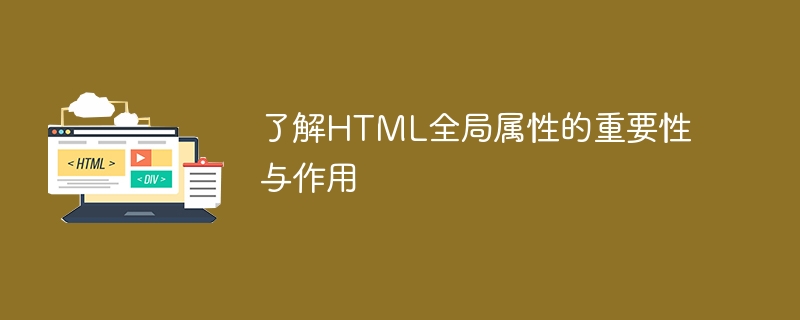

Understand the importance and role of HTML global attributes
With the rapid development of the Internet, web pages have become an important platform for people to obtain information, communicate, entertain and other activities. As one of the basic languages for building web pages, HTML (Hypertext Markup Language) is becoming more and more widely used. When writing HTML code, in addition to tags and the content within the tags, there are some global attributes that also play an important role. Global attributes are attributes that can be applied to all tags in HTML. They provide a method for general modification or control of tags.
Global attributes mainly include the following aspects:
The class attribute uses one or more class names to define the category of HTML elements. , this category can be used in CSS for setting styles. By adding the class attribute to an element, you can achieve global control over the style of the web page. The following is a sample code using the class attribute:
<!DOCTYPE html>
<html>
<head>
<style>
.red {
color: red;
}
.bold {
font-weight: bold;
}
</style>
</head>
<body>
<h1 class="red">这个标题是红色的</h1>
<p class="red">这个段落的颜色也是红色的</p>
<p class="bold">这个段落的字体加粗了</p>
</body>
</html>The id attribute is used to define a unique identifier for an HTML element. By adding an id attribute to an element, you can easily manipulate the element in JavaScript. An id attribute can only be used once in an HTML document. Here is a sample code using the id attribute:
<!DOCTYPE html>
<html>
<body>
<h1 id="heading">这是一个标题</h1>
<script>
var element = document.getElementById("heading");
element.style.color = "red";
</script>
</body>
</html>The style attribute is used to add CSS styles to a specific HTML element. By using the style attribute, you can style an element directly in HTML without using a CSS file. The following is a sample code using the style attribute:
<!DOCTYPE html> <html> <body> <h1 style="color:red;">这是一个红色的标题</h1> <p style="font-size:18px;">这是一个字号为18px的段落</p> </body> </html>
The title attribute is used to add prompt information to HTML elements. When the mouse is hovered over an element with the title attribute, a tooltip will be displayed containing the added text content. The following is a sample code using the title attribute:
<!DOCTYPE html> <html> <body> <h1 title="这是一个标题的提示信息">这是一个标题</h1> <p title="这是一个段落的提示信息">这是一个段落</p> </body> </html>
The lang attribute is used to define the language of the HTML element. By using the lang attribute, you can specify the language used by the element and help search engines and speech synthesizers determine the content they are manipulating. The following is a sample code using the lang attribute:
<!DOCTYPE html> <html lang="en"> <body> <h1>This is a heading</h1> <p>This is a paragraph</p> </body> </html>
The above are only part of the global attributes, and other attributes such as dir, hidden, tabindex, etc. also play an important role. Understanding and flexibly using these global properties can help us better control and customize the style, interaction, and semantics of web pages. At the same time, understanding global properties can also help improve the readability and maintainability of code, making web development more efficient and convenient.
The above is the detailed content of Understand the importance and function of global attributes in HTML. For more information, please follow other related articles on the PHP Chinese website!
 array_push
array_push
 Windows checks port occupancy status
Windows checks port occupancy status
 How to configure jdk environment variables
How to configure jdk environment variables
 Why is the mobile phone card limited to emergency calls?
Why is the mobile phone card limited to emergency calls?
 oicq
oicq
 The difference between JD.com's self-operated flagship store and its official flagship store
The difference between JD.com's self-operated flagship store and its official flagship store
 display: block;
display: block;
 The latest prices of the top ten virtual currencies
The latest prices of the top ten virtual currencies




